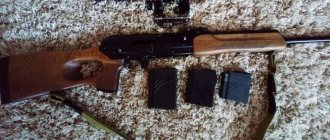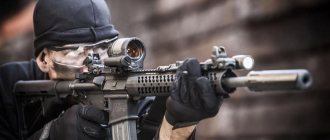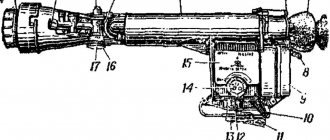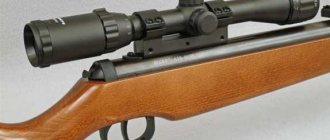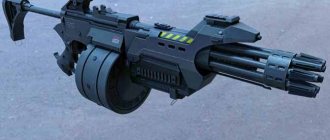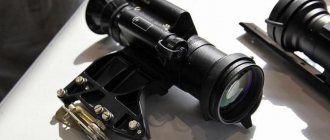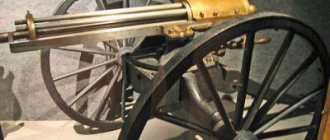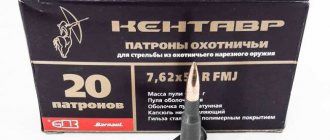Collimator sights are very convenient when shooting at short distances
But sometimes you have to change the batteries in them
Another type of distortion in the simplest collimator sights is target displacement due to refraction at the boundary of the air and the beam splitter lens (above). By using a double-layer lens with a beam splitter coating, the effect can be minimized
In the simplest collimator sights (below), reflection from the outer surface of the lens leads to a converging beam and an aiming error. When using a lens with a beam splitter coating, the beam is parallel and the scope is free from parallax
Not all sights with illuminated reticles or dots are red dots. For comparison, here is a diagram of an optical sight with a luminous reticle located in focus
The name of this scope speaks for itself. The chevron-shaped aiming dot can be illuminated in one of three ways: external light, tritium or LED
Trijicon's simple, reliable red dot sight is available in a variety of reticle options - dot, triangle or chevron.
While optical sights are an integral part of sniper weapons and are installed mainly on ultra-precise long-range rifles, red dot sights are mainly equipped with shotguns, rapid-fire automatic weapons and even pistols.
To understand the reasons for this difference in the areas of application of “optics” and “collimators”, as well as to evaluate the advantages of the latter, you should familiarize yourself with the most common sighting devices - open and optical sights.
General information
Some are interested in which red dot sights are the best for a particular type of weapon. Others ask why they are needed at all. The sight performs several important functions. It allows:
- Hunt in conditions of limited visibility. The sight mark is clearly visible in the dark, which allows you to make more effective shots.
- Shoot at moving targets. The collimator allows you to handle the accuracy and speed of pointing.
- Hit the target from an awkward position. Even if you are an ordinary shooter and not a special forces representative, sometimes situations arise when you need to fire a shot without prior preparation. A collimator will help solve this problem. It is also necessary if the shooter is forced to act in an awkward position.
Collimators simplify the training process for future shooters. Regardless of whether you use the best red dot sights or not, these devices help you practice your technique and successfully complete the initial level of shooting training.
Longer, but more accurate
In the simplest collimator sights (below), reflection from the outer surface of the lens leads to a converging beam and an aiming error. When using a lens with a beam splitter coating, the beam is parallel and the scope is free from parallax
The optical sight does not have the described disadvantage. In addition to its well-known property of visually bringing the target closer, that is, increasing its apparent size, it has another extremely important advantage, which we will talk about a little later.
Structurally, this type of sight is a long-focus lens with a depth of field from several meters or tens of meters to infinity. In other words, looking through the eyepiece of the sight, the shooter sees equally sharply both a nearby object and one located arbitrarily far away. In technical terms, almost all objects visible through an optical sight are located in the same focal plane. The “blind” zone remains only a certain distance directly in front of the sight. Here it would be appropriate to draw an analogy with classic cameras. When setting the lens to a distance of, for example, 3 meters, objects located at a distance of approximately 2 to 4 meters will be sharply visible. In this case, 3 meters is the focal point of the lens, and the range from 2 to 4 meters is its depth of field. When the distance scale is set to “infinity,” focusing is done at 8-10 meters, and the depth of field is “stretched” from an even smaller distance to infinity. Optical sights are adjusted in a similar way, with the only difference being that to reduce the negative influence of parallax (see sidebar), the focus point of the sight is usually made quite distant (about 50-100 meters). There are also special sights with an adjustable “focus”, like a camera.
Trijicon ACOG 3.5x35
In the same focal plane as the entire space viewed through the sight, there is an aiming reticle (it can be made in a variety of shapes - from the simplest crosshairs to complex rangefinder scales), which allows for ultra-precise aiming, unattainable with open sights. After all, only two elements are involved in the alignment process - the “mesh” and the target: both of them are sharply visible and perfectly controlled. And the fact that the target is completely visible, not blocked from below by the sight, affects the accuracy of the shot.
Not all sights with illuminated reticles or dots are red dots. For comparison, here is a diagram of an optical sight with a luminous reticle located in focus
At first glance, the optical sight is simply beyond competition. And indeed it is! But only within strictly defined limits - when you need to make an ultra-precise shot at the maximum distance at a stationary or sedentary target, and there is more than enough time for aiming. In any other situations, the advantages of “optics” are more than balanced by its disadvantages.
Trijicon TriPower
One of the disadvantages is the need for precise positioning of the shooter's eye relative to the sight. Shifting the pupil in any direction from the sight axis by several millimeters immediately distorts the observed picture - the field of view loses the outline of a regular circle, and the position of the aiming reticle ceases to correspond to the point of impact. The permissible longitudinal displacement of the eye relative to the optical axis has a very limited range.
The name of this scope speaks for itself. The chevron-shaped aiming dot can be illuminated in one of three ways: external light, tritium or LED. Replica #GS221 available
The main drawback, which is especially pronounced in “optics” with high magnification, remains an extremely limited field of view. The fact is that objects that do not fall into the viewing sector of the “optics” are located in focal planes much more distant than the aiming plane and are visible extremely blurred at the moment of aiming.
Therefore, when using “optics,” especially with high magnification, searching for even a stationary target through the eyepiece takes a lot of time. And when finding and holding an object in the field of view that is moving or appears for a short period of time, the effectiveness of “optics” is extremely low. For melee weapons, due to the “blind” zone, this type of sights is generally not applicable.
Varieties
There are passive and active sights. In the latter case, the device has additional illumination for the aiming mark. It does not depend in any way on the ambient light level. To aim, you only need to align the mark with the object of hunting. This allows you to make an accurate shot, even if the animal suddenly appears in your field of view. You can even shoot offhand. The active sight requires batteries to operate.
Passive devices provide good visibility of the mark only when there is sufficient illumination.
Open collimators
In this device, the light source is located at the base. It is worth noting that the device only has one lens. Open collimators are lightweight and small in size. That is, they do not disturb the weight distribution.
Advantages of the devices:
- light weight (the mass of closed collimators is 3-4 times greater);
- The devices have a very thin frame, and after a short period of time it becomes completely invisible;
- the shape of the sight is streamlined and compact in size, so there is no risk of getting caught on branches in the forest;
- The optics are easy to clean from dirt and snow (even without special wipes and products).
Additionally, we note that this type of device looks stylish on any weapon.
Closed collimators
For this type of sights, the mark is enclosed in a sealed housing. They also have a front lens and an eyepiece. The main advantage of these models is their high resistance to aggressive environmental influences, that is, they are designed for use in harsh conditions.
Main advantages:
- complete protection from dirt due to the tightness of the structure;
- expensive models are filled with nitrogen, which is additional protection against moisture;
- Reliable design that absorbs shock well.
Based on the operating principle of the projection system, reflector and holographic collimators are distinguished. For the latter, the role of the brand is a hologram, which is applied to the reflector.
Which red dot sight is better, open or closed? There is no clear answer to this question. Usually the choice is based on personal preference, as both types have their own advantages and disadvantages. When purchasing, you should be guided by the following factors:
- weight of weapon and sight;
- tasks that the shooter will perform.
To make shots offhand, it is better to choose an open collimator. The closed type is more suitable for those who shoot in difficult weather conditions.
Advantages
The main advantages include:
- Aim speed. Compared to an open shot, where three marks need to be aligned for an accurate shot, in collimators the rear sight and front sight are already aligned, so the time spent sighting is reduced and it is easier for the eyes to focus.
- Error in distortion. The lenses on red dot sights are simply concave to reflect light, so distortion is minimal. Almost all models on the market do not have an enlargement effect.
- Wide view. When aiming, there is no need to cover your other eye, which is undoubtedly very convenient.
- Thanks to its low weight it is very convenient to use.
How to choose a red dot sight
For smooth-bore weapons, an open-type device is more suitable. It is compact, lightweight, and gives a good overview. If you still prefer a closed collimator, then it is better to give preference to a holographic one, since it will allow you not to close your other eye when you need to aim. For many, this is an important selection criterion.
Which sight is better, collimator or optical? To answer this question, you need to decide on the purpose of purchasing the device. Experts give the following recommendations:
- To increase the degree of shooting accuracy, it is better to choose an optical sight. However, you should always remember that it seriously narrows the field of view and significantly makes the weapon heavier.
- For special services employees and experienced shooters, a holographic type collimator is more suitable. It allows you to reduce aiming time.
- For beginners, it is better to give preference to open-type devices.
We tried to answer the question of what is better, an optical sight or a collimator. Let us note once again that the choice depends on the purpose of purchasing the device and the skills of the weapon owner.
Question one: why a collimator? How is it better than an optical sight?
A collimator sight is a device that directs the beam of the aiming mark into the shooter’s eye parallel to the rays that form the image of the terrain in the sight lens.
Therefore, no matter how the shooter moves his eye relative to the lens, the position of the aiming mark will still correspond to the aiming line. This feature significantly speeds up the search for a target through the sight and the alignment of the aiming mark with the outline of the target. When choosing such a high-precision device, a red dot sight is usually compared with traditional optics. When selecting a sight for the most common type of hunting weapon - 12-gauge shotguns - the collimator has the following important advantages:
- The range of an accurate shot from a smooth-bore weapon is limited to a distance of 100 - 120 m. At such a distance, the ability to zoom in on the target is not needed, which means that the characteristics of the optical sight are clearly redundant. Or, in other words, the scope is more accurate than the shotgun itself. And since the characteristics of a complex optical sight are redundant, there is no need to overpay for them. The characteristics of the collimator sight are fully consistent with the capabilities of the weapon itself.
- When hunting with a smooth-bore weapon, shooting in most cases is done offhand. The time that can be spent aiming under such conditions is minimal, and hesitation in aiming will almost certainly result in a miss. The aiming speed through a collimator is much higher than the aiming speed with traditional optics, so the choice should be made in favor of a collimator.
- Aiming through a red dot sight does not deprive the shooter of the ability to use both eyes, and the narrow frame of an open red dot sight does not interfere with observing the movement of the target. This allows you to quickly adjust your sight when shooting at a moving target, for example, flying game. An optical sight often does not provide such an opportunity.
- Shooting from a 12-gauge shotgun is usually carried out with shot ammunition, which means that in order to hit, it is not necessary to align the aiming line as accurately as possible. Consequently, aiming through the collimator will be quite effective and fast.
Label
Sights are produced by many manufacturers. They can set different types of labels:
- a single dot with or without a circle;
- intersecting lines;
- triangle.
Every athlete or hunter should choose a scope based only on personal feelings. There are no best or worst models here. The shot will only be effective if the gun owner is comfortable.
In terms of reticle size, most models are presented in the range up to 2 MOA. This is a guarantee of shot accuracy, but not speed. This situation is corrected by increasing the brightness.
Shooting and sight adjustment
The method of zeroing the collimator is a personal matter of the owner. You can do this live, with a working cartridge, or use cold sighting kits. The main problem with cold zeroing is that it speeds up the process of adjusting the collimator, but cannot be final.
The sighting process cannot be completed without using the usual cartridge, taking into account the recoil factor. The easiest way is to mount the barrel on a stand and make adjustments through a series of 5-10 shots. The adjustment is made using the adjusting screws on the sighting device body.
More details about zeroing a reflex sight can be seen in the video:
Mounting type
On this issue, the opinions of experts are unanimous. The best choice is a collimator with a universal mount. It is convenient because you do not need to take the weapon to the store to buy a sight for “trying on”. If there are several different types of weapons, then one device will fit all models.
In most cases, manufacturers produce scopes with a Weaver mount. Its popularity is well deserved, since when used there is practically no risk that chips and cracks will appear on the weapon during a shot. There are also proprietary types of fastening, for example, TM Docter.
Types of sights for weapons
If you have a shotgun, then professionals recommend purchasing and installing a closed or holographic red dot sight on it. Regarding small-caliber and rifled carbines, an open sight is more suitable for them. When choosing a scope, it is advisable to take the gun with you to prevent purchasing the wrong mount.
ATTENTION! Closed-type models (some of them) with built-in brackets cannot be replaced, be careful!
Also, when purchasing, you need to check how many replacement tags are included with the product. Good collimators have more than 5 different types.
Brightness adjustment
In this matter, it is necessary to proceed from what type of hunting the gun owner prefers. For night shooting, an active collimator is preferable. It is desirable that it have at least 5 labels that can be changed.
If the hunt is carried out during the day, then it is hardly worth spending money on an active device, which is much more expensive than a passive one.
The most reliable manufacturers
Which red dot sight is better, depending on the manufacturer? Here is a list of the most popular:
- Eotech (USA). This company has a huge line of collimators. The products of this company are in service with many American military units. The company primarily produces open-type devices. The cost of sights is quite high, but in this case the buyer pays for quality, and not for the brand.
- Hakko (Japan). The products of this company belong to the high and medium price segment. The range is very wide, from lightweight open-type models to tubular structures. Particularly trustworthy are the varieties of the model called Bed.
- Sightmark (USA). The manufacturer produces models of sights for various types of weapons, including large-caliber ones. The company boasts awards received for high-quality collimators, as well as the low cost of its products. The brand is popular among athletes.
- Aimpoint (Sweden). The products of this company are characterized by a high degree of impact resistance and are not afraid of mechanical damage and corrosion. The price of sights is quite high.
- Burris (USA). The company specializes in the production of open collimators. They are extremely popular among hunters and athletes.
- Leapers (USA). This manufacturer operates in the middle price segment and offers a wide range of collimators for both small-sized and smooth-bore weapons.
- Docter (Germany). The company specializes in the production of sights for sports and entertainment purposes. There is a line for hunting weapons. Collimators are characterized by high resistance to recoil and mechanical damage.
Among the Russian ones, the best collimator sights are “Cobra” (produced at Izhevsk Moto (Krasnogorsk), Veber (St. Petersburg). Collimator sights are also produced in Belarus. One of the companies specializing in this product is Zenit-BelOMO.
Features of operation
Collimator sights are often compared to a laser pointer, but there is a significant difference between them. The lens of the device displays an aiming mark, which is illuminated by the electronic controller and is visible only to the shooter. Whereas in a laser sight, the index dot is also displayed on the target. In hunting conditions, this causes a lot of inconvenience, because the animal may be frightened by the random glare of the laser and hide.
The collimator automatically performs aiming, focusing on a beam of rays that is reflected from a distant observation object. Depending on the types of collimator sights, the mark in the lens can have different shapes, which ensures high shooting accuracy from different types of weapons. Some models provide the ability to quickly switch aiming marks. A large assortment of collimator sights is offered by the Spetstechconsulting online store; on the pages of this resource you can find all types of sights from global manufacturers.
According to the principle of operation, collimator sights are usually classified into two types:
- Active – the reticle is constantly lit, and the device operates on built-in batteries;
- Passive - designed to operate in autonomous mode and do not require connection to external energy sources.
Some models allow you to remove the battery without dismantling the sight, which is extremely convenient when you need to not lose sight of the target, but constantly keep it in sight. Active sights are practical, but they are not recommended for use in cold temperatures.
Through-configuration collimator sights make it possible to aim with one or two eyes to choose from, and the so-called “blind” models, which are often called “stereoscopic collimators,” are designed for aiming with two eyes at the same time.
Rating of closed type models
Above we described what these devices are. What are the best closed red dot sights? The top three are:
- Model Z1x20 AVIS from Pilad (VOMZ). During the tests, the high impact resistance of the device was confirmed. The body is made of aircraft grade aluminum. The model has 9 brightness levels. The 3 MOA reticle allows for close-range shooting.
- BED-5 MR-02 (Hakko). The model has 4 marks for the sight. The device perfectly tolerates recoil from the 12-gauge. The scope is suitable for hunting in any season, as the body is completely sealed and well protected from moisture.
- Micro H-1 (Aimpoint). Designed for hunting and sport shooting. Has a built-in battery designed for 5.5 years. The scope has 12 levels of brightness and the mark is 2 MOA. Using the Parallax free system, the parallax effect is completely and instantly eliminated. The sight can be used in both very high and low atmospheric temperatures.
If you have a limited budget, it is still recommended to choose products from domestic manufacturers. Pilad devices are considered the best red dot sights in the low price segment. They are easy to use and versatile.
Shooting stamps
In Hollywood action films, the weapons of participants in shootouts (and now in news reports, machine guns of peacekeeping and non-peacekeeping soldiers) are sometimes equipped with unusual sighting devices. In some cases, they vaguely resemble “conventional” optical sights with short tubes and internal illumination. In others, they look like aliens from the future. They are united only by the presence of lenses and an internal glow that is clearly visible in the twilight. These are the so-called collimator sights.
Collimator sights are very convenient when shooting at short distances
While optical sights are an integral part of sniper weapons and are installed mainly on ultra-precise long-range rifles, red dot sights are mainly equipped with shotguns, rapid-fire automatic weapons and even pistols.
But sometimes you have to change the batteries in them
To understand the reasons for this difference in the areas of application of “optics” and “collimators”, as well as to evaluate the advantages of the latter, you should familiarize yourself with the most common sighting devices - open and optical sights.
Rating of devices for air guns
According to experts and shooters, the best red dot sights for pneumatics are:
- Aimpoint 9000SC. The main advantage of the model is that there is no harm to the human eye when used, since there is no laser light. The body itself has a matte anti-slip coating. Tolerates mechanical stress well. The case is completely sealed and can even survive immersion in water up to 5 meters.
- Aimpoint H34L. Excellent resistance to mechanical damage and shaking. Characterized by the presence of a precise adjustment mechanism. There is a simple calibration system and 12 brightness levels. The aiming mark is 2 MOA.
- Veber 1x22x33. The model has 4 types of aiming marks. A protective cover can be installed on the lens. Impact load is rated at 3700 J.
Which reflex sight for pneumatics is best for beginner hunters? Experts recommend paying attention to Veber 1x20x30. This is an ideal choice for rifles such as IZH-60, 61 and MP-512.
Difference from mechanical, optical, holographic sights
Collimator sights perform the same functions as other types of sighting systems, but the principle of their operation is characterized by a comparison of different parameters, including:
- The collimator forms a mark with parallel rays directed towards the shooter. The differences from sights with a classic optical system are represented by the method of forming the aiming mark. Thus, classical optics have a metal mesh embedded in one lens.
- No time is required to align the front sight and rear sight when using a collimator. The level of illumination for conducting aimed fire has no practical significance.
- The ability to shift the shooter relative to the aiming axis significantly distinguishes a collimator sight from others - the mark remains on the target.
One of the collimator models worth special mention is the holographic sight. What distinguishes it from the classic one is the use of a laser instead of incoming light streams, as well as a holographic mark that can look like a three-dimensional image. The response speed is slightly higher than the classical model.
View through the reflex sight
Characteristics that somewhat reduce the value of collimator sights include the need to use power sources, the need for periodic replacement, as well as poor diopter zoom of the target.
Rating of devices for rifled weapons
This product segment also has its leaders. The best red dot sights for rifled weapons today are:
- Bed-17-30 MR-02 (Hakko). This is a compact and lightweight scope. Its weight is 137 g. The model is universal, suitable for installation on all types of weapons, including pistols. Has 4 brand levels. The battery is rated for 300 hours. The warranty on the sight is 10 years. The model is in the middle price segment.
- Sight III 3.5 (Docter). A distinctive feature of this open model is its small dimensions: 46 x 25 mm. The weight of the device is only 25 g. Therefore, the collimator can be used even on shotguns with shotguns.
- XPS 3 (EOTech). This is a holographic type open sight. It has compact dimensions - 90 x 51 x 61 mm. Its weight is 227 g. It runs on one battery with a lifespan of 600 hours. It is possible to manually adjust the brightness. Compatible with night vision devices.
Among Russian-made collimators, one can highlight the P1x20 Avis model from VOMZ. Suitable for installation on any type of weapon. It is produced in 2 variations, differing in the type of fastening.
Shooting Features
After purchasing the device, you need to shoot it. First, you need to study the theoretical part, understand how the collimator sight works and how to correct its aiming at the target, and then zeroing the collimator will not cause any problems.
Installation and configuration
High-quality branded devices are provided complete with mounts for two mechanisms - dovetail and Picatinny rail. Small arms are also manufactured with appropriate mounts on the body, therefore, installing the device on the barrel consists only of firmly fixing it in the right place by tightly tightening the clamping screws. They need to be tightened tightly, but moderately, so as not to break the thread.
Before shooting a red dot sight, you need to carry out its initial setup. Setting up is not particularly difficult; any hunter can figure out how to set up a red dot sight. In expensive models, you can adjust not only the brightness, but also the shape of the front sight. Most often, the choice is between a dot, a cross, a circle with a dot, and a cross with a dot. Brightness is adjusted depending on the lighting.
At the same time, there is no need to be afraid that the point in the sight will be seen by the enemy located on the other side of the weapon, because the visible beam of light is very weak and is reflected in the direction of the shooter’s eye. Thanks to this device, the front sight is visible only to the person looking through the sight, and to no one else.
What to choose for 12 gauge
Traditionally, open collimators are preferred for such weapons. This is due to the fact that they are light, so they do not upset the balance.
The best red dot sight for 12 gauge is Pilad P1x42 Weaver (VOMZ). The model is open and provides the hunter with a wide 180-degree field of view. This allows you to shoot offhand. The device has a backlight with adjustable brightness.
The best red dot sight for weapons up to 12 gauge is the Micro H1 (Aimpoint). This is a universal model that can be installed on other types of weapons, even SPP. The body of the device is reinforced, which allows it to withstand the most severe shock loads, even two-vector recoil. Tolerates changes in ambient temperatures very well.
The sight weighs only 114 g, despite the fact that it is a closed type. It has good energy efficiency indicators. The battery is rated for 50,000 hours.
